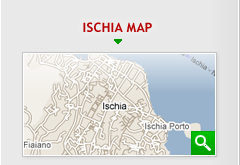Location

Ischia Island
Topography and history
Covering an area of 46.33 square kilometers, Ischia is the eighth largest Italian island and the largest in the Bay of Naples.Neighbouring islands are Capri, Procida and Vivara.
It is a volcanic island predominantely hilly and its perimeter is approximately 35 kms (18 miles). The geographical position endows it with a mild cliamte, which attracts hundreds of visitors annually.The tourist season lasts from the beginning of March until the end of November.
The gold mine
The thermal waters of Ischia have really become the gold mine od the island and are considered therapeutic for several conditions. On Ischia one can find thermal gardens with pools at different temperatures, from 28 to 40 degrees centigrade, close to the sea. These complexes open in early April and close at the end of October.
The climatologist Christopher Mennella (1908 - 1976) described Ischia as " The Climatic jewel of Italy". It has an average temperature of 17 degrees centigrade. August is the hottest month while January the coldest.
Beaches
Rocks dominate this island's shoreline, but they have also helped create many beaches. Barano Maronti is the largest beach on the island - almost 2 kilometers, long with pumice stone cliffs. The seawater here is thermal, while going towards Sant'Angelo one can find steaming geysers (fumaroles). Hot springs can be also found in Nitrodi.
Login
Phone: +39 081 877 06 04 - Fax: +39 081 877 02 58 - E-mail: info@3istd.com

